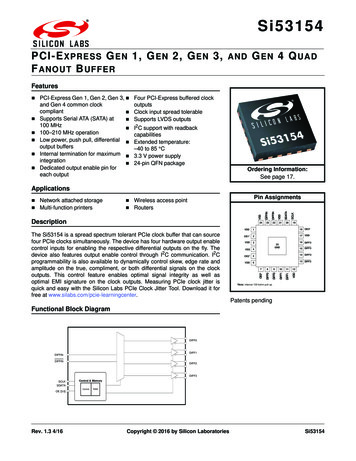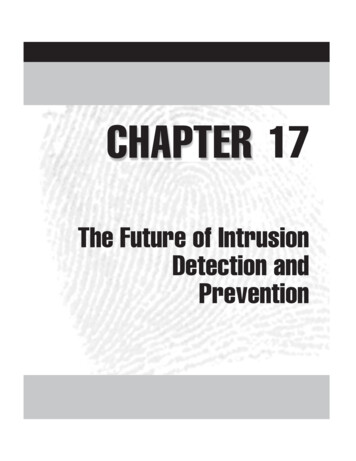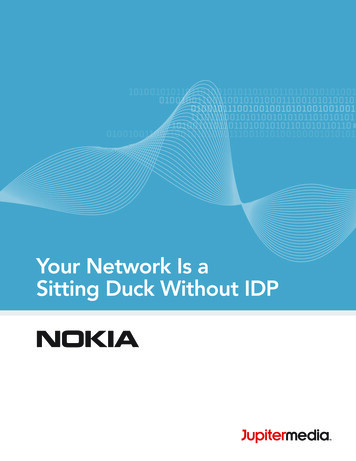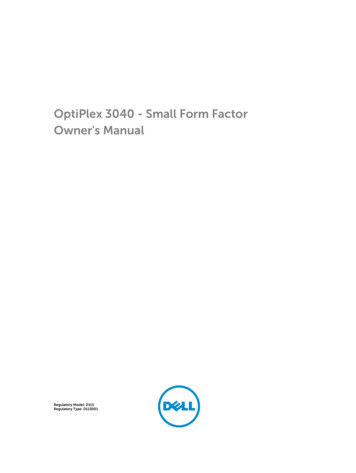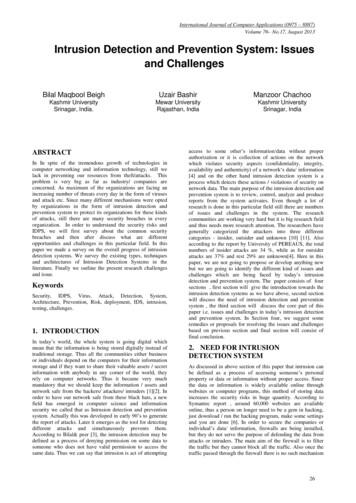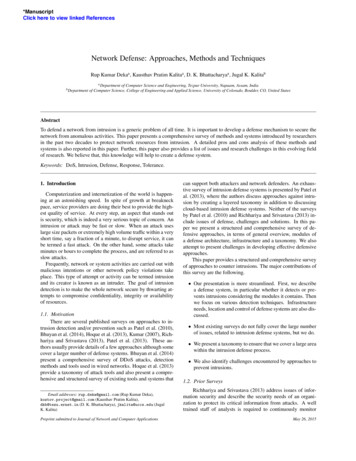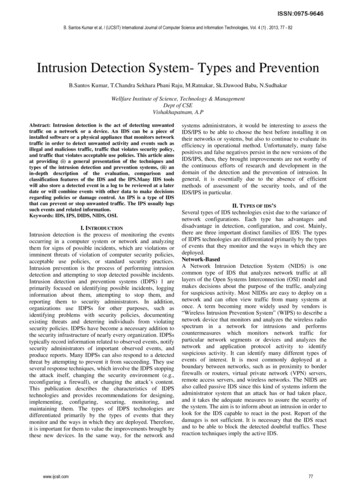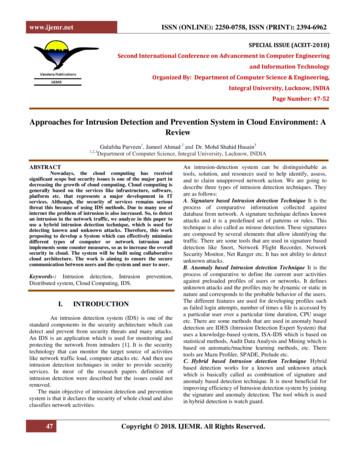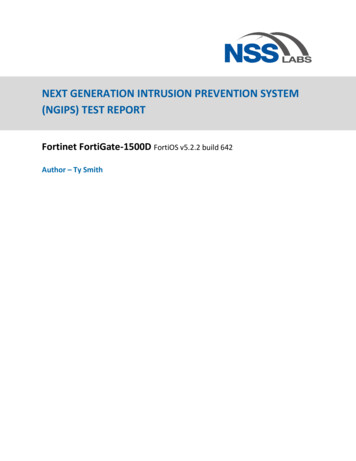
Transcription
NEXT GENERATION INTRUSION PREVENTION SYSTEM(NGIPS) TEST REPORTFortinet FortiGate-1500D FortiOS v5.2.2 build 642Author – Ty Smith
NSS LabsNext Generation Intrusion Prevention System Test Report – Fortinet FortiGate-1500DOverviewNSS Labs performed an independent test of the Fortinet FortiGate-1500D FortiOS v5.2.2 build 642. Theproduct was subjected to thorough testing at the NSS facility in Austin, Texas, based on the NextGeneration Intrusion Prevention System (NGIPS) Methodology v1.0 available at www.nsslabs.com. Thistest was conducted free of charge and NSS did not receive any compensation in return for Fortinet’sparticipation.While the companion comparative reports on security, performance, and total cost of ownership (TCO)will provide comparative information about all tested products, this individual test report providesdetailed information not available elsewhere.NSS research indicates that the majority of enterprises tune their NGIPS. Therefore, NSS’ evaluatesNGIPS products as optimally tuned by the vendor prior to testing. Every effort is made to deploy policiesthat ensure the optimal combination of security effectiveness and performance, as would be the aim ofa typical customer deploying the device in a live network environment.ProductFortinet FortiGate-1500DFortiOS v5.2.2 build 642Exploit Block RateNSS-Tested Throughput99.2%111,727 MbpsEvasionsStability and ReliabilityPASSPASSFigure 1 – Overall Test Results (Tuned Policies)Using a tuned policy, the FortiGate-1500D blocked 99.2% of exploits. The device proved effective againstall evasion techniques tested. The device also passed all stability and reliability tests.The Fortinet FortiGate-1500D is rated by NSS at 11,727 Mbps, which is higher than the vendor-claimedperformance; Fortinet rates this device at 11Gbps. NSS-tested throughput is calculated as an average ofall the "real-world” protocol mixes and the 21 KB HTTP response-based capacity tests.1 The exploit block rate is defined as the percentage of exploits and live (real-time) drive-by exploits blocked under test.2
NSS LabsNext Generation Intrusion Prevention System Test Report – Fortinet FortiGate-1500DTable of ContentsOverview. 2Security Effectiveness . 5Exploit Library . 5False Positive Testing . 5Coverage by Attack Vector . 5Coverage by Impact Type . 6Coverage by Date . 7Coverage by Target Vendor . 8Coverage by Result . 8Coverage by Target Type . 8Live (Real-Time) Drive-by Exploits . 9Application Control (Optional Test) . 10User/Group Identity (ID) Aware Policies (Optional Test). 10Resistance to Evasion Techniques . 11Performance . 12Raw Packet Processing Performance (UDP Throughput) . 12Latency – UDP . 13Connection Dynamics – Concurrency and Connection Rates . 13HTTP Connections per Second and Capacity . 15HTTP Capacity with No Transaction Delays. 15HTTP Capacity with Transaction Delays . 16Application Average Response Time – HTTP . 16Real-World Traffic Mixes. 17Stability and Reliability . 18Management and Configuration . 19Total Cost of Ownership (TCO) . 20Installation (Hours) . 20Purchase Price and Total Cost of Ownership . 21Value: Total Cost of Ownership per Protected-Mbps . 21Detailed Product Scorecard . 22Test Methodology . 29Contact Information . 303
NSS LabsNext Generation Intrusion Prevention System Test Report – Fortinet FortiGate-1500DTable of FiguresFigure 1 – Overall Test Results (Tuned Policies) . 2Figure 2 – Number of Exploits Blocked in % . 5Figure 3 – Coverage by Attack Vector . 6Figure 4 – Product Coverage by Impact . 7Figure 5 – Product Coverage by Date . 7Figure 6 – Product Coverage by Target Vendor . 8Figure 7— Number of Live Exploits Blocked in % . 9Figure 8 – Application Control . 10Figure 9 – User/Group ID Aware Policies . 10Figure 10 – Resistance to Evasion Results . 11Figure 11 – Raw Packet Processing Performance (UDP Traffic) . 12Figure 12 – UDP Latency in Microseconds . 13Figure 13 – Concurrency and Connection Rates . 14Figure 14 – HTTP Connections per Second and Capacity . 15Figure 15 – HTTP Capacity with Transaction Delays . 16Figure 16 – Average Application Response Time in Milliseconds . 16Figure 17 – Real World Traffic Mixes . 17Figure 18 – Stability and Reliability Results . 18Figure 19 – Sensor Installation Time in Hours . 20Figure 20 – 3-Year TCO. 21Figure 21 – Total Cost of Ownership per Protected-Mbps . 21Figure 22 – Detailed Scorecard . 284
NSS LabsNext Generation Intrusion Prevention System Test Report – Fortinet FortiGate-1500DSecurity EffectivenessThis section verifies that the device under test (DUT) is capable of enforcing the security policyeffectively.Exploit LibraryIn order to accurately represent the protection that may be achieved, NSS evaluates the DUT using atuned policy.Exploit Testing: NSS’ security effectiveness testing leverages the deep expertise of NSS engineers togenerate the same types of attacks used by modern cybercriminals, utilizing multiple commercial, opensource, and proprietary tools as appropriate. With over 1800 exploits, this is the industry’s mostcomprehensive test to date. Most notable, all of the exploits and payloads in these tests have beenvalidated such that: A reverse shell is returnedA bind shell is opened on the target, allowing the attacker to execute arbitrary commandsA malicious payload is installedThe system is rendered unresponsiveEtc.ProductFortinet FortiGate-1500DFortiOS v5.2.2 build 642Total Number ofExploits RunTotal NumberBlockedBlockPercentage1898189499.8%Figure 2 – Number of Exploits Blocked in %False Positive TestingThe Fortinet FortiGate-1500D FortiOS v5.2.2 build 642 correctly identified traffic and did not fire IPSalerts for non-malicious content.Coverage by Attack VectorBecause a failure to block attacks could result in significant compromise and impact to critical businesssystems, network intrusion prevention systems should be evaluated against a broad set of exploits.Exploits can be categorized into two groups: attacker-initiated and target-initiated. Attacker-initiatedexploits are threats executed remotely against a vulnerable application and/or operating system by anindividual while target-initiated exploits are initiated by the vulnerable target. With target-initatedexploits, the most common type of attack experienced by the end user, the attacker has little or nocontrol as to when the threat is executed.5
NSS LabsNext Generation Intrusion Prevention System Test Report – Fortinet FortiGate-1500DFigure 3 – Coverage by Attack VectorCoverage by Impact TypeThe most serious exploits are those that result in a remote system compromise, providing the attackerwith the ability to execute arbitrary system-level commands. Most exploits in this class are“weaponized” and offer the attacker a fully interactive remote shell on the target client or server.Slightly less serious are attacks that result in an individual service compromise, but not arbitrary systemlevel command execution. Typical attacks in this category include service-specific attacks, such as SQLinjection, that enable an attacker to execute arbitrary SQL commands within the database service. Theseattacks are somewhat isolated to the service and do not immediately result in full system-level access tothe operating system and all services. However, by using additional localized system attacks, it may bepossible for the attacker to escalate from the service level to the system level.Finally, there are the attacks which result in a system or service-level fault that crashes the targetedservice or application and requires administrative action to restart the service or reboot the system.These attacks do not enable the attacker to execute arbitrary commands. Still, the resulting impact tothe business could be severe, as the attacker could crash a protected system or service.6
NSS LabsNext Generation Intrusion Prevention System Test Report – Fortinet FortiGate-1500DFigure 4 – Product Coverage by ImpactCoverage by DateThis graph provides insight into whether a vendor ages out protection signatures aggressively in order topreserve performance levels. It also reveals where a product lags behind in protection for the mostrecent vulnerabilities. NSS will report exploits by individual years for the past 10 years. Exploits olderthan 10 years will be consolidated into the oldest “bucket.”Figure 5 – Product Coverage by Date7
NSS LabsNext Generation Intrusion Prevention System Test Report – Fortinet FortiGate-1500DCoverage by Target VendorThe NSS exploit library covers a wide range of protocols and applications representing a wide range ofsoftware vendors. This graph highlights the coverage offered by the Fortinet FortiGate-1500D for someof the top vendor targets (out of more than 70) represented for this round of testing.Figure 6 – Product Coverage by Target VendorCoverage by ResultThese tests determine the protection provided against different types of exploits based on the intendedaction of those exploits, for example, arbitrary execution, buffer overflow, code injection, cross-sitescripting, directory traversal, or privilege escalation. Further details are available to NSS clients viainquiry call.Coverage by Target TypeThese tests determine the protection provided against different types of exploits based on the targetenvironment, for example, web server, web browser, database, ActiveX, Java, browser plugins, etc.Further details are available to NSS clients via inquiry call.8
NSS LabsNext Generation Intrusion Prevention System Test Report – Fortinet FortiGate-1500DLive (Real-Time) Drive-by ExploitsWhile the NSS exploit library covers diverse protocols and applications representing a wide range ofsoftware vendors (broad coverage), the live (real-time) drive-by exploits focus on current threats (livecoverage).2 Protection from web-based exploits targeting client applications, also known as “drive-by”downloads, can be effectively measured in the NSS unique live test harness through a series ofprocedures that measures the stages of protection.Unlike traditional malware that is downloaded and installed, “drive-by” attacks first exploit a vulnerableapplication and then silently download and install malware. This means that there are threeopportunities to break the chain of events leading to a successful compromise:1. URL access (reputation)2. Exploit3. MalwareTo test vendors’ ability to block current threats, NSS collects real threats and attack methods that cybercriminals and other threat actors use against the NSS global threat intelligence network.Success or failure is determined based on whether the device blocks the attack. Attacks that are notsuccessfully blocked will be measured as a failure.Figure 7 depicts the block percentage for live drive-by exploits.ProductTotal Number ofLive ExploitsTotal NumberBlockedBlock Percentage61360498.5%Fortinet FortiGate-1500DFortiOS v5.2.2 build 642Figure 7— Number of Live Exploits Blocked in %2See the NSS Cyber Advanced Warning System for more details.9
NSS LabsNext Generation Intrusion Prevention System Test Report – Fortinet FortiGate-1500DApplication Control (Optional Test)An NGIPS should provide granular control based upon applications, not just ports. This capability isneeded to re-establish a secure perimeter where unwanted applications are unable to tunnel over portstraditionally used by common and pervasive protocols such as HTTP/S. As such, granular applicationcontrol is a requirement of an NGIPS since it enables the administrator to define security policies basedupon applications rather than ports alone. Figure 8 depicts whether Fortinet FortiGate-1500D passed orfailed the application control test. Demonstration of application control functionality is optional forversion 1.0 of the NGIPS methodology. Vendors that opt out of this test will be marked as “N/A.”Test ProcedureResultBlock Unwanted ApplicationsN/AFigure 8 – Application ControlUser/Group Identity (ID) Aware Policies (Optional Test)An NGIPS should be able to identify users and groups and apply security policy based on identity. Wherepossible, this should be achieved via direct integration with existing enterprise authentication systems(such as Active Directory) without the need for custom server-side software. This allows theadministrator to create even more granular policies. Figure 9 depicts whether Fortinet FortiGate-1500Dpassed or failed the user/group ID test. Demonstration of user/group aware policy functionality isoptional for version 1.0 of the NGIPS methodology. Vendors that opt out of this test will be marked as“N/A.”Test ProcedureResultUsers Defined via NGIPS Integration with Active DirectoryN/AUsers Defined in NGIPS DB (where AD integration is not available)N/AFigure 9 – User/Group ID Aware Policies10
NSS LabsNext Generation Intrusion Prevention System Test Report – Fortinet FortiGate-1500DResistance to Evasion TechniquesEvasion techniques are a means of disguising and modifying attacks at the point of delivery in order toavoid detection and blocking by security products. Failure of a security device to correctly handle aparticular type of evasion potentially will allow an attacker to use an entire class of exploits for whichthe device is assumed to have protection. This renders the device virtually useless. Many of thetechniques used in this test have been widely known for years and should be considered minimumrequirements for the NGIPS product category.Providing exploit protection results without fully factoring in evasion can be misleading. The moreclasses of evasion that are missed—IP packet fragmentation, stream segmentation, RPC fragmentation,SMB and NetBIOS evasions, URL obfuscation, HTML obfuscation, payload encoding and FTP evasion—the less effective the device. For example, it is better to miss all techniques in one evasion category (say,FTP evasion) than one technique in each category, which would result in a broader attack surface.Furthermore, evasions operating at the lower layers of the network stack (IP packet fragmentation orstream segmentation) will have a greater impact on security effectiveness than those operating at theupper layers (HTTP or FTP obfuscation). This is because lower-level evasions will potentially impact awider number of exploits; therefore, missing TCP segmentation is a much more serious issue thanmissing FTP obfuscation.Figure 10 provides the results of the evasion tests for Fortinet FortiGate-1500D.Test ProcedureResultIP Packet FragmentationPASSStream SegmentationPASSRPC FragmentationPASSSMB & NetBIOS EvasionsPASSURL ObfuscationPASSHTML ObfuscationPASSFTP EvasionPASSPayload EncodingPASSIP Packet Fragmentation TCP SegmentationPASSIP Packet Fragmentation MSRPC FragmentationPASSIP Packet Fragmentation SMB EvasionsPASSStream Segmentation SMB & NETBIOS EvasionsPASSTCP Split HandshakePASSFigure 10 – Resistance to Evasion Results11
NSS LabsNext Generation Intrusion Prevention System Test Report – Fortinet FortiGate-1500DPerformanceThere is frequently a trade-off between security effectiveness and performance. Because of this tradeoff, it is important to judge a product’s security effectiveness within the context of its performance (andvice versa). This ensures that new security protections do not adversely impact performance andsecurity shortcuts are not taken to maintain or improve performance.Raw Packet Processing Performance (UDP Throughput)This test uses UDP packets of varying sizes generated by test equipment. A constant stream of theappropriate packet size – with variable source and destination IP addresses transmitting from a fixedsource port to a fixed destination port – is transmitted bi-directionally through each port pair of theDUT.Each packet contains dummy data, and is targeted at a valid port on a valid IP address on the targetsubnet. The percentage load and frames per second (fps) figures across each in-line port pair are verifiedby network monitoring tools before each test begins. Multiple tests are run and averages taken wherenecessary.This traffic does not attempt to simulate any form of “real-world” network condition. No TCP sessionsare created during this test, and there is very little for the state engine to do. The aim of this test ispurely to determine the raw packet processing capability of each in-line port pair of the DUT, and itseffectiveness at forwarding packets quickly in order to provide the highest level of network performanceand lowest latency.Figure 11 – Raw Packet Processing Performance (UDP Traffic)12
NSS LabsNext Generation Intrusion Prevention System Test Report – Fortinet FortiGate-1500DLatency – UDPNext generation intrusion prevention systems that introduce high levels of latency lead to unacceptableresponse times for users, particulary where multiple security devices are placed in the data path. Theseresults show the latency (in microseconds) as recorded during the UDP throughput tests at 90% ofmaximum load.Latency - UDPMicroseconds64 Byte Packets4128 Byte Packets4256 Byte Packets4512 Byte Packets51024 Byte Packets61514 Byte Packets8Figure 12 – UDP Latency in MicrosecondsConnection Dynamics – Concurrency and Connection RatesThe use of sophisticated test equipment appliances allows NSS engineers to simulate real-world trafficat multi-Gigabit speeds as a background load for the tests.The aim of these tests is to stress the inspection engine and determine how it handles high volumes ofTCP connections per second, application layer transactions per second, and concurrent openconnections. All packets contain valid payload and address data, and these tests provide an excellentrepresentation of a live network at various connection/transaction rates.Note that in all tests the following critical “breaking points” – where the final measurements are taken –are used: Excessive concurrent TCP connections – Latency within the DUT is causing unacceptable increase inopen connections on the server-side.Excessive response time for HTTP transactions – Latency within the DUT is causing excessive delaysand increased response time to the client.Unsuccessful HTTP transactions – Normally, there should be zero unsuccessful transactions. Oncethese appear, it is an indication that excessive latency within the DUT is causing connections to timeout.13
NSS LabsNext Generation Intrusion Prevention System Test Report – Fortinet FortiGate-1500DFigure 13 – Concurrency and Connection Rates14
NSS LabsNext Generation Intrusion Prevention System Test Report – Fortinet FortiGate-1500DHTTP Connections per Second and CapacityThe aim of these tests is to stress the HTTP detection engine and determine how the DUT copes withnetwork loads of varying average packet size and varying connections per second. By creating genuinesession-based traffic with varying session lengths, the DUT is forced to track valid TCP sessions, thusensuring a higher workload than for simple packet-based background traffic. This provides a testenvironment that is as close to “real world” as it is possible to achieve in a lab environment, whileensuring absolute accuracy and repeatability.HTTP Capacity with No Transaction DelaysEach transaction consists of a single HTTP GET request and there are no transaction delays (that is, theweb server responds immediately to all requests). All packets contain valid payload (a mix of binary andASCII objects) and address data. This test provides an excellent representation of a live network (albeitone biased towards HTTP traffic) at various network loads.Figure 14 – HTTP Connections per Second and Capacity15
NSS LabsNext Generation Intrusion Prevention System Test Report – Fortinet FortiGate-1500DHTTP Capacity with Transaction DelaysTypical user behavior introduces delays between requests and reponses, for example, “think time,” asusers read web pages and decide which links to click next. This group of tests is identical to the previousgroup except that these include a 5-second delay in the server response for each transaction. This hasthe effect of maintaining a high number of open connections throughout the test, thus forcing thesensor to utilize additional resources to track those connections.Figure 15 – HTTP Capacity with Transaction DelaysApplication Average Response Time – HTTPApplication Average Response Time – HTTP (at 90% Maximum Load)Milliseconds2,500 Connections Per Second – 44 KB Response1.735,000 Connections Per Second – 21 KB Response1.0810,000 Connections Per Second – 10 KB Response0.7420,000 Connections Per Second – 4.5 KB Response0.4740,000 Connections Per Second – 1.7 KB Response0.73Figure 16 – Average Application Response Time in Milliseconds16
NSS LabsNext Generation Intrusion Prevention System Test Report – Fortinet FortiGate-1500DReal-World Traffic MixesThis test measures the performance of the device under test in a “real-world” environment byintroducing additional protocols and real content, while still maintaining a precisely repeatable andconsistent background traffic load. Different protocol mixes are utilized based on the intended locationof the device under test (network core or perimeter) to reflect real use cases. For details about realworld traffic protocol types and percentages, see the Next Generation Intrusion Prevention System(NGIPS) Methodology v1.0 available at www.nsslabs.com.Figure 17 – Real World Traffic MixesThe FortiGate-1500D performed above vendor-claimed throughput claimed for all of the “real-world”mixes with the exception of the financial and the enterprise perimeter mix.17
NSS LabsNext Generation Intrusion Prevention System Test Report – Fortinet FortiGate-1500DStability and ReliabilityLong-term stability is particularly important for an in-line device, where failure can produce networkoutages. These tests verify the stability of the DUT along with its ability to maintain securityeffectiveness while under normal load and while passing malicious traffic. Products that cannot sustainlegitimate traffic (or that crash) while under hostile attack will not pass.The device is required to remain operational and stable throughout these tests, and to block 100% ofpreviously blocked traffic, raising an alert for each. If any non-allowed traffic passes successfully, causedby either the volume of traffic or the DUT failing open for any reason, the device will fail the test.Test ProcedureResultBlocking Under Extended AttackPASSPassing Legitimate Traffic Under Extended AttackPASSBehavior Of The State Engine Under Load Attack Detection/Blocking - Normal LoadPASS State Preservation - Normal LoadPASS Pass Legitimate Traffic - Normal LoadPASS State Preservation - Maximum ExceededPASS Drop Traffic - Maximum ExceededPASS Protocol Fuzzing & Mutation –Detection PortPASS Power FailPASS Persistence of DataPASSFigure 18 – Stability and Reliability ResultsThese tests also determine the behavior of the state engine under load. All NGIPS devices must choosewhether to risk denying legitimate traffic or allowing malicious traffic once they run low on resources.Dropping new connections when resources (such as state table memory) are low, or when traffic loadsexceed the device capacity will theoretically block legitimate traffic, but maintain state on existingconnections (preventing attack leakage).18
NSS LabsNext Generation Intrusion Prevention System Test Report – Fortinet FortiGate-1500DManagement and ConfigurationSecurity devices are complicated to deploy; essential systems such as centralized management consoleoptions, log aggregation, and event correlation/management systems further complicate the purchasingdecision.Understanding key comparison points will allow customers to model the overall impact on networkservice level agreements (SLAs), estimate operational resource requirements to maintain and managethe systems, and better evaluate required skill/competencies of staff.Enterprises should include management and configuration during their evaluation, focusing on thefollowing at a minimum: General Management and Configuration – how easy is it to install and configure devices, anddeploy multiple devices throughout a large enterprise network? Policy Handling – how easy is it to create, edit, and deploy complicated security policies across anenterprise? Alert Handling – how accurate and timely is the alerting, and how easy is it to drill down to locatecritical information needed to remediate a security problem? Reporting – how effective is the reporting capability, and how readily can it
NSS Labs Next Generation Intrusion Prevention System Test Report - Fortinet FortiGate-1500D 2 Overview NSS Labs performed an independent test of the Fortinet FortiGate-1500D FortiOS v5.2.2 build 642. The product was subjected to thorough testing at the NSS facility in Austin, Texas, based on the Next Generation Intrusion Prevention System (NGIPS) Methodology v1.0 available at www.nsslabs.com.
